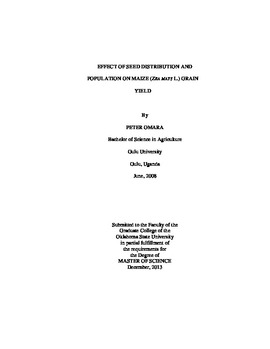| dc.description.abstract | Maize planting is normally accomplished by hand in the developing world where two or more seeds are placed per hill with a heterogeneous plant spacing and density. To understand the interaction between seed distribution and distance between hills on grain yield and nitrogen (N) uptake, experiments were established in 2012 and 2013 at Lake Carl Blackwell (LCB) and Efaw Agronomy Research Stations, near Stillwater, OK. A randomized complete block design was used with three replications and ten treatments; and a factorial treatment structure of 1, 2 and 3 seeds per hill using inter-row spacings of 0.16, 0.32 and 0.48m. Normalized Difference Vegetation Index (NDVI), Intercepted Photosynthetically Active Radiation (IPAR), grain yield and N uptake were measured. Results showed that, on average, NDVI and IPAR increased with number of seeds per hill by 9 and 14%, and decreased with plant spacing by 10 and 11%, respectively. However, they were not good predictors of grain yield. Significant interaction effects (p<0.01) for grain yield were observed at Efaw in both years but not at LCB. In 2012, highest grain yield of 11.68 Mg ha-1 was achieved at 0.48m spacing with 3 seeds per hill, while lowest grain yield of 6.51 Mg ha-1 was obtained at 0.48m spacing with 1 seed per hill. In 2013, highest grain yield of 8.97 Mg ha-1 was attained at 0.16m with 1 seed per hill while lowest grain yield of 4.01 Mg ha-1 was attained at 0.32m spacing with 1 seed per hill. Treatments, including interaction, in both years and locations did not have any influence on N uptake. However, N uptake was higher at locations with very poor yield. This study showed that planting up to 3 seeds per hill at 0.16m spacing can reduce maize yield by 12 to 15% and that planting 1 seed per hill reduces seeding rate by 66% compared to 3 seeds but no grain N advantage was observed. Considering seed spacing variability at a range used in this study, yield and economic benefits were sufficient to support production of maize at 0.16 m inter-row spacing with 1 seed per hill. | |
